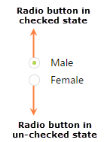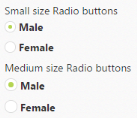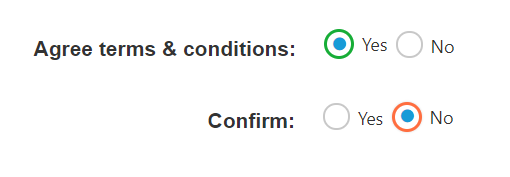Easy Customization
24 Jul 20199 minutes to read
Checked status
You have options to set the state of the radio button as either checked or unchecked. When you select any option from the group of radio buttons, a dot mark appears inside the circle. This is called the Checked state. Previously selected radio buttons in this group are unselected that is they go to the unChecked state. The Checked property is used to set the state of the radio button.
The following steps explain the details about rendering the Radio Button with the Checked option
In the ASPX page, add the following input elements to configure Radio Button.
<%--Here checked and unchecked type of radio buttons are rendered in same group
set checked state of radio button as follows--%>
<ej:RadioButton Name="Gender" ID="Radio_checked" runat="server" Size="Small" Checked="true">
</ej:RadioButton>
<label for="Radio_checked" class="clslab">
Male</label>
<br />
<ej:RadioButton Name="Gender" ID="Radio_unchecked" runat="server" Size="Small" Checked="false">
</ej:RadioButton>
<label for="Radio_unchecked" class="clslab">
Female</label>Configure the CSS styles to align the radio buttons.
<style type="text/css">
.page-align
{
margin: 100px;
}
</style>
Text
Specifies the text content for the radio button. In previous programs, separate labels were created for each radio button. But now you have the option to set the text for radio button by using the Text property. So here you do not have to add a label tag for each radio button in the HTML code.
The following steps explain the details about rendering the Radio Button with Text and without using the label tag options.
In the ASPX page, add the following input elements to configure the Radio Button.
<%--radio button with text property--%>
<ej:RadioButton Name="Gender" ID="RadBtn_male" runat="server" Size="Small" Checked="true"
Text="Male">
</ej:RadioButton>
<br />
<ej:RadioButton Name="Gender" ID="RadBtn_female" runat="server" Size="Small" Checked="false"
Text="Female">
</ej:RadioButton>Configure the CSS styles to align the radio buttons.
<style type="text/css">
.page-align
{
margin: 100px;
}
</style>
Size
You can render the Radio Button in different sizes. There are some predefined size options available for rendering a Radio Button in an easy way. Each size option has different height and width. It mainly avoids the complexity in rendering Radio Button with complex CSS class.
| Property | Description |
|---|---|
| Small | Creates radio button with Built-in small size height, width specified. |
| Medium | Creates radio button with Built-in medium size height, width specified. |
The following steps explain the details about rendering Radio Button with different size options.
In the ASPX page, add the following input elements to configure Radio Button.
<%-- small and medium size of radio buttons in same group
By default, here no one radio button is checked--%>
Small size Radio buttons
<br />
<ej:RadioButton Name="Gender" ID="Radio_Male" runat="server" Size="Small" Checked="true">
</ej:RadioButton>
<label for="Radio_Male">
Male</label>
<br />
<ej:RadioButton Name="Gender" ID="Radio_Female" runat="server" Size="Small">
</ej:RadioButton>
<label for="Radio_Female">
Female</label>
<br />
Medium size Radio buttons
<br />
<ej:RadioButton Name="Gender1" ID="Radio1_Male" runat="server" Size="Medium" Checked="true">
</ej:RadioButton>
<label for="Radio1_Male">
Male</label>
<br />
<ej:RadioButton Name="Gender1" ID="Radio1_Female" runat="server" Size="Medium">
</ej:RadioButton>
<label for="Radio1_Female">
Female</label>Configure the CSS styles to align the radio buttons
<style type="text/css">
.page-align
{
margin: 100px;
}
</style>
RTL Support
In some cases, you need to use right-to-left alignment. You can give RTL support by using EnableRTL property. RTL mode works when you use the Text property in Radio Button. The Radio Buttons and text are aligned in the right-to-left format. For example, when text is right-aligned and Radio button is left-aligned, after you apply right-to-left alignment, these positions are interchanged.
The following steps explain the details about rendering the Radio Button with right-to-left alignment support. Here the Text property is necessary.
In the ASPX page, add the following button elements to configure Radio Button.
<%--set radio button with right to left format--%>
<div class="page-align">
<table class="rightAlign">
<tr>
<td>
<ej:RadioButton Name="Gender" ID="RadBtn_male" runat="server" Size="Small" Text="Male"
EnableRTL="true">
</ej:RadioButton>
</td>
</tr>
<tr>
<td>
<ej:RadioButton Name="Gender" ID="RadBtn_female" runat="server" Size="Small" Text="Female"
EnableRTL="true">
</ej:RadioButton>
</td>
</tr>
</table>
</div>In the above mentioned code, the Text property has been used. In LTR format, the RadioButton is on the left side. In RTL format, the RadioButton appears on the right side. Here the Text property is used and the EnableRTL property is set as “true”. It changes the alignment to right-to-left.
Configure the CSS styles to align the RadioButtons.
<style type="text/css">
.page-align
{
margin: 100px;
}
.rightAlign
{
text-align: right;
}
</style>
Styles Customization
RadioButton allows you to customize its appearance by using user-defined CSS and custom skin options such as colors and backgrounds. To apply custom themes, use CssClass property. CssClass property sets the root class for RadioButton theme.
By using this CssClass, you can override the existing styles under the theme style sheet. The theme style sheet applies theme-specific styles like colors and backgrounds. From the root class, you can customize the RadioButton control theme.
In the following example, the border color and border width of the active RadioButton is customized through the custom classes to create the success, and danger indication with RadioButton.
<span><b>Agree terms & conditions:</b></span>
<span style="margin-left: 15px">
<ej:RadioButton Name="radio1" ID="Radio_checked" Text="Yes" runat="server" Size="Medium" Checked="true" CssClass="success">
</ej:RadioButton>
<ej:RadioButton Name="radio1" ID="Radio_unchecked" Text="No" runat="server" Size="Medium" Checked="false" CssClass="warning">
</ej:RadioButton>
</span>
<br>
<br>
<span><b>Confirm:</b></span>
<span style="margin-left: 15px">
<ej:RadioButton Name="radio2" ID="RadioButton3" Text="Yes" runat="server" Size="Medium" Checked="true" CssClass="success">
</ej:RadioButton>
<ej:RadioButton Name="radio2" ID="RadioButton4" Text="No" runat="server" Size="Medium" Checked="false" CssClass="warning">
</ej:RadioButton>
</span><style>
.success .e-spanicon.e-rad-active,
.success .e-spanicon.e-rad-active:hover {
border-color: #17ad37;
border-width: 2px;
}
.warning .e-spanicon.e-rad-active,
.warning .e-spanicon.e-rad-active:hover {
border-color: #ff6e40;
border-width: 2px;
}
</style>